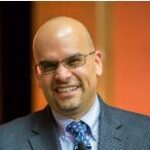El Futuro Executive Director Luke Smith spoke to USA TODAY about the need for more Spanish-speaking, culturally responsive behavioral health care specialists in North Carolina and across the county.
Read more here: http://bit.ly/318qhjO
Habla Español? Hispanics face growing mental health care crisis
It was soon after Jasmine Alcala gave birth to her son, Benjamin, that her mind flooded with thoughts of catastrophe.
For Alcala, now 38, tragedy lurked everywhere. At her Long Beach, California, home, which she rarely left while caring for her newborn, she feared a home invasion. Behind the wheel, her heart raced at the possibility of a fatal car accident. At the grocery store, she fretted over the potential of armed robbery.
And nothing was as terrifying as the idea of not being with her son.
Eventually, Alcala and her husband, Ruben Alcala, sought help. She joined several peer support groups for postpartum women and visited two different therapists. But neither therapist was Latinx, nor did they speak Spanish, making it difficult for Alcala, who is Mexican American, to communicate some of her deepest thoughts and feelings.
“The therapist just couldn’t understand my cultural background because it wasn’t her own,” Alcala says. “Communicating needs to family was where I could see the biggest difference. And if you’re not from that background … I don’t know how to explain it.”
Spanish-speaking Americans across the U.S. say they have a hard time finding mental health care services in their native language. Only 5.5% of U.S. psychologists say they’re able to administer mental health care services in Spanish, according to a survey released by the American Psychological Association in September 2016, the most recent data available. In all, 44.9% of psychologists said they were “quite or extremely knowledgeable” about working with Hispanic patients.
Therapists who speak a foreign language
About 1 in 10 therapists surveyed reported being able to provide services in a language other than English.
The demand for full-time psychologists within the Hispanic community is expected to surge 30% by the year 2030. That’s second highest only to “other racial/ethnic minority groups” – including Asians, Native Americans and multiracial people – with a growth of 32%, according to the American Psychological Association. African Americans will see an 11% increase, and whites a 2% decrease.
Critics say mental health providers are simply not keeping up with the nation’s growing Hispanic population, which reached 59.9 million in 2018, or roughly 18% of the U.S. population.
Many Latinx Americans want therapists who understand their community
This disparity is noteworthy, in part, because Latinx Americans face unique mental health issues compared to the country’s population at large.
The National Alliance on Mental Illness found Hispanics tend to struggle with common mental health disorders such as generalized anxiety disorder, major depression, post-traumatic stress disorder (PTSD) and alcoholism at an average rate, but are at higher risk for severe mental health problems, in part because of the poor quality of treatment they tend to receive.
Rougly 36% of Hispanics with depression receive mental health care, as opposed to 60% of non-Hispanic whites.
Hispanics are also less likely than non-Hispanic whites to take antidepressants, according to a 2014 report from Albert Einstein College of Medicine in New York City. The study’s leading author, Sylvia Wassertheil-Smoller, says that the most important factor preventing treatment is insurance status.
“There was a huge difference between people who were insured and people who were not,” Smoller says.
Jane Delgado, president of the National Alliance for Hispanic Health, says she has also seen immigration affect the mental health of later-generation Latinx Americans, both directly and indirectly.
“We don’t have to look too far back to understand those roots,” Delgado says.
Meanwhile, Latina adolescents attempt suicide more often than any other group of female teenagers nationwide, according to the Center for Disease Control and Prevention’s 2017 Youth Risk Behavior Surveillance.
Delgado says the most at-risk girls tend not to be new arrivals, but the daughters of first-generation immigrants, who “have to marry the culture of their older family members with the culture that is their future.”
Delgado says receiving medical care in your native language is especially important in mental health because conversation is a part of the treatment.
But only 4.4% of American psychologists identified as Hispanic. Meanwhile, roughly 53 million Americans speak Spanish, or more than 16% of the total population, the American Psychological Association found.
“You have to show the person you’re talking to that you value them as an individual,” Delgado, a practicing psychologist, says.
Too many patients, not enough therapists
Mental health experts and those within the Latinx community have attributed the treatment gap to a combination of factors.
Luis Cornejo, 33, works as a marriage and family therapist for Instituto Familiar de La Raza, a nonprofit mental health clinic in San Francisco’s Mission District. In caring for an entirely Spanish-speaking caseload, he says Latinx culture tends to dismiss the need for mental health care.
“For many of them, they see mental health as a very Western thing that doesn’t really correlate with the traditions of Latinoamerica,” Cornejo says.
Irán Barrera, 45, has spent his career studying the mental health care treatment gap. From 2014 to 2017, he directed the Consejo Project, a graduate program within Fresno State University’s Department of Social Work Education that studied the cultural frameworks that shape behavioral health within the Latinx community.
Barrera says he’s found the “cold” nature of mental health institutions in the U.S. can dissuade Latinx people from returning to therapy.
“The medical industry has its own language and its own culture,” Barrera says. “You come in here, then they tell you what’s wrong with you and it’s, ‘Thanks for coming.’ Latinos, for the most part, we like to be asked ‘How’s your day? How’s your kids? How’s your family?’ So, right away, we feel discontented with the institutions.”
The most pressing issue, however, is the lack of bilingual, bicultural mental health services.
When Brandie Carlos, 31, of Los Angeles, lost one of her best friends to suicide in February 2018, she knew she would need additional support. She wanted to speak with a therapist, and she was certain she wanted that person to be Latina.
But even living in Los Angeles County, – an area with 9% of the country’s total Hispanic population – finding a therapist that fit her needs wasn’t a simple task, she says.
“For people that are the first in their family to attend therapy, there’s a lot to overcome before you get there,” Carlos says. “I ended up finding a Latina therapist and I was just able to talk about certain things about my culture, or talk in Spanglish when I needed, and it was really helpful.”
This experience drove Carlos, who works in digital marketing, to design a website to help Latinx Americans search for bilingual therapists in their area who are culturally competent and speak Spanish. Therapy For Latinx has since expanded to include 180 therapists in 20 states as of June 2019. Carlos says the website’s Instagram page averages about 1,500 new followers per month.
But Delgado says more needs to be done to grow the ranks of therapists who can seamlessly treat Hispanic patients. She says the U.S. mental health care system and educational institutions need to do more to attract and retain Latinx and Spanish-speaking people, including by overcoming financial or other barriers.
“The bottom line is that a lot of people are not going into mental health, period, and that is especially so for Hispanics, because we are also less likely to have the means to pursue an advanced degree,” Delgado says.
Mental health providers see high demand for Spanish services
Across the nation, some private practices and health care institutions say they are working to provide more bilingual and bicultural mental health care at low costs, but the demand is beyond their abilities.
El Futuro, a nonprofit mental health and substance use disorder clinic based in Durham, North Carolina, is working to serve as many Spanish-speaking patients as possible. The state’s Hispanic population grew 22% from 2010 through 2017, according to census data.
El Futuro has a staff of about 20 therapists and two psychiatrists, and treats patients from 20 of North Carolina’s 100 counties. It offers reduced or free care for some patients.
“While we’re seeing 1,800 people per year, we’re still not seeing enough,” says executive director Luke Smith, a psychiatrist who helped found the clinic in 2001.
In 1977, Cynthia Telles founded the Spanish Speaking Psychosocial Clinic at the University of California, Los Angeles. Over the past 42 years, Telles says her clinic has helped thousands of Spanish-speaking patients, all the while training generations of mental health care professionals who go on to provide bilingual care at different institutions across the country.
Telles, who is also the director of the UCLA Hispanic Neuropsychiatric Center of Excellence, says there are very few, if any, federally funded programs like her own at other public institutions.
“There has to be support from the government for this kind of training to produce more mental health professionals that want to go back and serve the Latino/Hispanic community, but, also, there has to be the will, interest and commitment from the academic institutions to do the same,” Telles says.
In New York City, the Montefiore Medical Center in the Bronx has implemented regular mental health screenings into their annual physicals, in an effort to extend intersectional mental health care to the borough’s majority-minority neighborhood, which is 43.6% black and 56.4% Latino, according to the Census Bureau. This means setting up patients who screen positive for mental illness with immediate consultations with in-house mental health clinicians, says Miguelina Germán, director of pediatric behavioral health services for Montefiore Medical Group.
“This model really works for all underserved communities,” Germán says.
In Miami, Anabel Bejarano is a clinical psychologist who trains future generations of bilingual, bicultural therapists as director of the master’s program in counseling at the University of Miami in Coral Gables, Florida. She also recently opened a private practice. But before she could hang a sign outside of her window, Bejarano says she already had a full caseload. About 80% of her clients receive therapy in Spanish.
For a few clients who can’t afford to pay full price, she lowers her fees. “It’s a drop in the bucket,” she says, but she’s doing what she can.
Treatment in Spanish can improve care for some Hispanics
For Alcala, finding a Spanish-speaking therapist ultimately made the difference in her recovery.
She eventually was referred to a therapy group for Latinas struggling with postpartum anxiety and depression. Surrounded by women with similar lived experiences, Alcala finally felt understood. Her new therapist is a Spanish-speaking, Latino therapist.
Alcala says seeking out such treatment has helped her realize she can express herself and felt heard.
“Even though we grow up here in America and we’re American citizens and we consider ourselves proud Americans, there are things that we grow up with in our culture or in our family that are difficult to translate to an English-speaking therapist or English-speaking community,” Alcala says. “Being able to have someone with a Spanish-speaking background who understands the invisible rules of our culture just really made sense.”


 Alvely Alcántara, LCSW
Alvely Alcántara, LCSW Rossy C. Garcia, MEd
Rossy C. Garcia, MEd  Katy Sims, MD
Katy Sims, MD  Everardo Aviles, LCSW, LCAS (Eve)
Everardo Aviles, LCSW, LCAS (Eve) As a medical anthropologist and social work researcher, Dr. Gulbas’ research embodies interdisciplinarity through the integration of applied theories of health and human development with qualitative and ethnographic methodologies. Her work seeks to understand how people—children, families, and providers—navigate complex sociocultural landscapes in the pursuit of mental health. Most of her work, to date, focuses attention on developing more robust interpretations of suicide risk. With funding from the National Institutes of Mental Health, this body of research has contributed to advancements in theoretical and empirical knowledge of the broader contexts within which youth suicide risk is situated.
As a medical anthropologist and social work researcher, Dr. Gulbas’ research embodies interdisciplinarity through the integration of applied theories of health and human development with qualitative and ethnographic methodologies. Her work seeks to understand how people—children, families, and providers—navigate complex sociocultural landscapes in the pursuit of mental health. Most of her work, to date, focuses attention on developing more robust interpretations of suicide risk. With funding from the National Institutes of Mental Health, this body of research has contributed to advancements in theoretical and empirical knowledge of the broader contexts within which youth suicide risk is situated.  R. Gabriela Barajas-Gonzalez is a developmental psychologist and an assistant professor of Population Health at NYU Grossman School of Medicine. Dr. Barajas-Gonzalez is the principal investigator of a study that examines the impact of immigration-related threat and stress on school communities. She earned a PhD in developmental psychology from Columbia University and hold a BA in human biology from Stanford University. Dr. Barajas-Gonzalez is the daughter of Mexican immigrants and a first gen college student.
R. Gabriela Barajas-Gonzalez is a developmental psychologist and an assistant professor of Population Health at NYU Grossman School of Medicine. Dr. Barajas-Gonzalez is the principal investigator of a study that examines the impact of immigration-related threat and stress on school communities. She earned a PhD in developmental psychology from Columbia University and hold a BA in human biology from Stanford University. Dr. Barajas-Gonzalez is the daughter of Mexican immigrants and a first gen college student. Dr. Parra-Cardona is an Associate Professor in the Steve Hicks School of Social Work (SHSSW) at the University of Texas at Austin. At the SHSSW, he serves as Coordinator for Mexico and Latin American initiatives. He also serves as Area Director for Research at the UT Austin Latino Research Institute. Dr. Parra-Cardona’s program of research is focused on the cultural adaptation of evidence-based parenting interventions for low-income Latinx populations in the US and Latin America.
Dr. Parra-Cardona is an Associate Professor in the Steve Hicks School of Social Work (SHSSW) at the University of Texas at Austin. At the SHSSW, he serves as Coordinator for Mexico and Latin American initiatives. He also serves as Area Director for Research at the UT Austin Latino Research Institute. Dr. Parra-Cardona’s program of research is focused on the cultural adaptation of evidence-based parenting interventions for low-income Latinx populations in the US and Latin America. Bianka Reese, PhD, MSPH is a research scientist and program evaluator specializing in adolescent and young adult sexual and reproductive health. Her previous research in the experiences of Latinx LGBTQ+ youth stems from her work as the Research and Evaluation Manager at SHIFT NC (Sexual Initiatives For Teens), where she led largescale evaluations of multilevel, community-based sexual health promotion initiatives and research projects aimed at elevating the voices of diverse youth in North Carolina. Dr. Reese is currently the Senior Research Strategist at Creative Research Solutions, LLC, an award-winning national evaluation, research, and assessment firm.
Bianka Reese, PhD, MSPH is a research scientist and program evaluator specializing in adolescent and young adult sexual and reproductive health. Her previous research in the experiences of Latinx LGBTQ+ youth stems from her work as the Research and Evaluation Manager at SHIFT NC (Sexual Initiatives For Teens), where she led largescale evaluations of multilevel, community-based sexual health promotion initiatives and research projects aimed at elevating the voices of diverse youth in North Carolina. Dr. Reese is currently the Senior Research Strategist at Creative Research Solutions, LLC, an award-winning national evaluation, research, and assessment firm. Tania Connaughton-Espino, MPH is an independent researcher focused on adolescent and young adult sexual and reproductive health. Her interest in the experiences of Latinx LGBTQ+ youth stems from her previous work with SHIFT NC (Sexual Initiatives For Teens), where she led the training and evaluation department, conducted capacity-building workshops for youth serving professionals including on the topic of how to be more affirming of LGBTQ youth, and from her extensive experience working with the Latinx population in NC.
Tania Connaughton-Espino, MPH is an independent researcher focused on adolescent and young adult sexual and reproductive health. Her interest in the experiences of Latinx LGBTQ+ youth stems from her previous work with SHIFT NC (Sexual Initiatives For Teens), where she led the training and evaluation department, conducted capacity-building workshops for youth serving professionals including on the topic of how to be more affirming of LGBTQ youth, and from her extensive experience working with the Latinx population in NC. Maru Gonzalez, EdD is an Assistant Professor and Youth Development Specialist in the Department of Agricultural and Human Sciences at North Carolina State University. Her areas of inquiry include youth development with a focus on activism, social justice, and the experiences of LGBTQ+ young people across familial, school, and community contexts.
Maru Gonzalez, EdD is an Assistant Professor and Youth Development Specialist in the Department of Agricultural and Human Sciences at North Carolina State University. Her areas of inquiry include youth development with a focus on activism, social justice, and the experiences of LGBTQ+ young people across familial, school, and community contexts.  Nayeli Y. Chavez-Dueñas, PhD
Nayeli Y. Chavez-Dueñas, PhD Hector Y. Adames, PsyD
Hector Y. Adames, PsyD